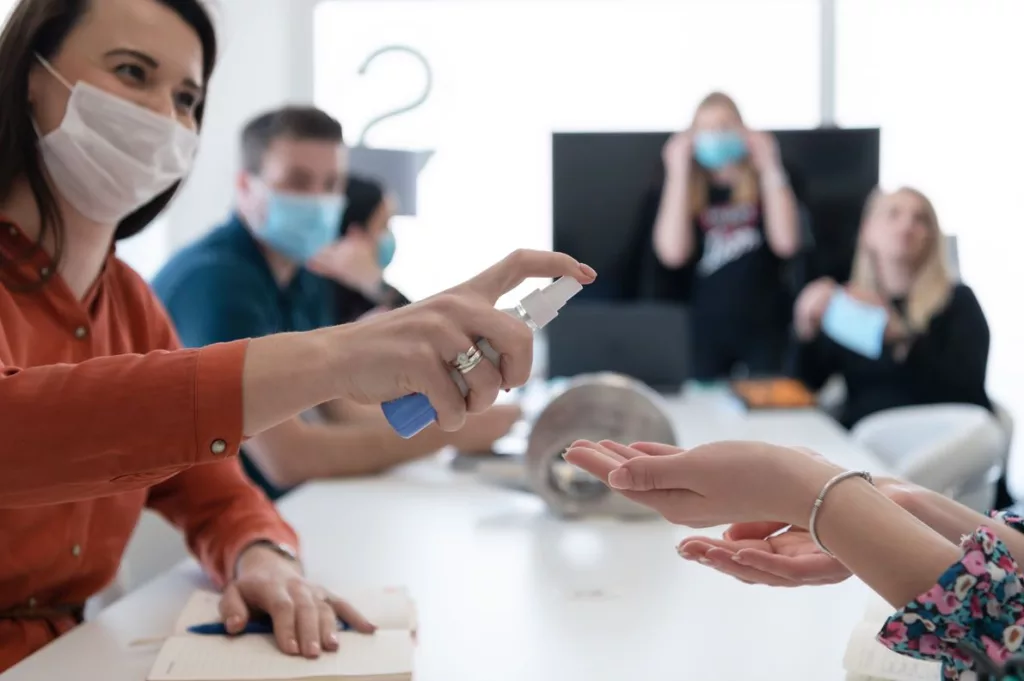No one wants to get sick. From an economic standpoint, staying home from work might put your job in jeopardy and/or decrease the amount you get paid while you take time to recover. As a result, people turn to all sorts of methods for protection from germs and viruses.
Health conscious people attempt anything from old wives tales like putting sliced onions in your socks at night, to over the counter preventatives and proven natural remedies like increasing your vitamin D and vitamin C intake.
One great thing you can do to ward off illness is the regular addition of alcohol-based hand sanitizers in your daily routine. This has become increasingly popular as an effective way to kill germs and viruses. But how does it work?
Washing your hands with soap and water is best according to the Centers for Disease Control and Prevention (CDC), but isn’t always possible. Using alcohol-based hand sanitizers in these cases can help stop the spread of viral illnesses.

How do alcohol-based sanitizers work to kill viruses
According to research from 2020, the article Sanitizing agents for virus inactivation and disinfection says, ethyl alcohol and isopropyl rubbing alcohol can both eliminate various pathogens. Rubbing alcohol’s primary component is isopropyl alcohol, whereas drinking alcohol typically contains ethyl alcohol.
The concentration of these alcohols and the sort of virus determine their effectiveness depends on how effective they are. Nonenveloped viruses are those without a lipid membrane, whereas enclosed viruses have a lipid membrane. Nonenveloped viruses typically exhibit greater resistance to disinfectants.
Hand sanitizer is an extremely effective alcohol-based product that kills viruses due to the nature of the alcohol-based cleaning products. These sanitizers contain denatured ethyl or isopropyl alcohol and act by destroying the outer membrane of the virus, a chemical process that will eventually break it down and kill it.
Types of viruses that can be killed by these products
It’s no secret that when people don’t practice good hand hygiene they are more likely to facilitate cross-contamination of household surfaces and spread infection. We can mitigate these health risks by disinfecting surfaces but we also know that many viruses can be killed when hands are cleaned with Common Sense hand sanitizer.
In fact, it is one of the most effective ways of killing germs and protecting yourself and those around you from many contagious illnesses. From common colds to rhinoviruses, coronaviruses, and more. These types of hand sanitizer can kill germs and cleaners work to provide a level of protection.
According to this medically reviewed paper on Alcohol Sanitizer, “Ethanol, the most common alcohol ingredient, appears to be the most effective alcohol against viruses other bacteria, whereas propanol is considered a better bactericidal alcohol.
The combination of alcohol may also have a synergistic effect. The concentration of alcohol concentration in hand sanitizers also changes its efficacy, with one study demonstrating that a hand rub with 85% ethanol content was significantly better at reducing bacterial populations than preparations of 60% to 62% ethanol.”
Many studies suggest that alcohol sanitizers made with 60% or higher alcohol content provide a more effective barrier against certain types of viruses and common bacteria than washing hands with soap and water. As such, opting for an alcohol-based solution – especially one that contains at least 60% ethanol or 70% isopropyl – should be your go-to method for cleaning your hands throughout the day.
Proper use and application techniques for optimal effectiveness
Proper hygiene practices must be adopted to help prevent the spread of this virus. While washing your hands with soap and water is ideal, another effective tool for combatting germs and infections is the use of hand sanitizers. For optimal effectiveness follow the manufacturer’s instructions for use.
Proper application of alcohol-based hand sanitizer, like Common Sense, involves making sure to cover your entire hands with a generous amount of product and rubbing it until your hands are dry, which typically takes around 20 seconds.
Don’t forget to apply the product between your fingers, nails, and wrists when applying hand sanitizer as these areas tend to have higher concentrations of bacteria. Keeping these few tips in mind can maximize the effectiveness of using hand sanitizer as part of your daily hygiene routine.
Benefits of using Alcohol Based Common Sense Sanitizing products

Convenience
Alcohol-based hand sanitizer is extremely convenient for those on the go because it does not require access to running water or soap. Instead, a person can simply apply a few drops of the gel onto their hands and rub until dry.
This makes it ideal for people who are constantly on the move — such as busy parents or travelers — since they don’t have to worry about finding a sink every time they need to wash their hands. In addition, applying the gel takes much less time than washing with soap and water, making it quicker and easier overall.
Portability
Unlike traditional soap and water, sanitizer comes in small bottles that are easy to carry around wherever you go. You will always have the ability to clean your hands without having to worry if you’ll be able to find a working sink with access to soap.
Effectiveness
Alcohol kills germs, plain and simple. This means that the hand sanitizer consumers buy that are made of more than 60% alcohol solutions are able to quickly kill off bacteria and viruses on contact in order to help prevent the spread of infection from one person to another.
All healthcare professionals should routinely use alcohol hand sanitizers consumers and inform the public about their advantages. Alcohol can quickly eradicate the majority of non-spore-forming microbes and lower infection rates. According to data, alcohol hand sanitizers improve hand cleanliness and lessen the spread of microorganisms in medical facilities.
Common Sense long lasting hand sanitizer goes above and beyond these typical alcohol based disinfectants because our formula bonds with skin to ensure long lasting protection. Our product is also preferable because in addition to alcohol’s germicidal effects, it contains other ingredients which help keep skin soft and hydrated after use.
This makes Common Sense long lasting hand sanitizer especially helpful in preventing skin irritation caused by frequent washing with harsh soaps or detergents.
Safety
In general, alcohols are thought to be safer than detergents. There are a fewer serious risks with the use of alcohol-based hand sanitizers (ABHS), with their only absolute contraindication being extreme allergic reactions (like anaphylaxis to aliphatic alcohols).
Common Sense long lasting hand sanitizer preparation works to keep skin feeling soft and moisturized, but other leading brands are still linked to a number of skin responses. Dryness, itching, irritation, pruritis, and skin cracking are all symptoms of contact irritant dermatitis, which can range in severity from moderate to alarming.
The symptoms of allergic contact dermatitis can also range from mild to serious, and they occasionally include respiratory distress.
According to some research, using ABHS frequently by professionals may result in unintentional alcoholization (via inhalation and dermal contact). Other studies have shown that healthcare employees who sanitized their hands 30 times a day had no blood alcohol levels that could be measured. These levels are regarded as being well within the safe range, but more investigation is necessary to assess the long-term health risks and impacts on the fetuses of pregnant healthcare employees.

The Effect Hand Sanitizer Has On Viruses
Common Sense long-lasting hand sanitizer is an effective and convenient tool to help kill germs, disinfect surfaces, and prevent the spread of infections. Not only do they kill germs on contact with surfaces long but they also come in small bottles that can be easily carried around wherever you go.
Both ethyl alcohol and isopropyl alcohol can destroy viruses with lipid-rich cell walls. Along with HIV, hepatitis B, and herpes viruses, and cold viruses fall under this umbrella. Alcohol disables a virus’ ability to operate through cell membrane by altering the viral membrane’s structure.
Using alcohol-based hand sanitizers is the next best thing to washing hands with detergent and water. When this choice is not accessible, people can use waterless hand sanitizer gels, foams or sprays that contain 60–90% alcohol.
Rubbing alcohol can be used to clean dirty surfaces around the house, but handling it should be done with care, since rubbing alcohol alone may damage some surfaces. A safer way to clean surfaces is with Common Sense long lasting surface protectant. This product uses the same germ killing technology as our Common Sense hand sanitizer, but with a more concentrated formula made to sanitize frequently touched surfaces. This product is also perfect for cleaning surfaces that come in contact with food around your home or business.
It is important to ensure that your hand sanitizing solution contains at least 60% ethanol or 70% isopropyl for maximum effectiveness against certain viruses and bacteria. By following proper application techniques when using Common Sense products, you will have a better chance of staying healthy!
Frequently Asked Questions
Q: Can I get potentially fatal alcohol poisoning from drinking alcohol sanitizer?
A: While it’s generally considered a critical tool to keep our hands germ-free, some people have raised concerns about the possibility of getting alcohol poisoning from hand sanitizer. And they’re right to be worried.
While alcohol sanitizer is safe to use as directed on the label, ingesting large amounts of it can lead to potentially fatal consequences. Use alcohol sanitizer as directed and avoid drinking it altogether to stay safe and healthy.
Q: How do alcohol molecules break down germs?
A: Alcohol is a powerful disinfectant and alcohol-based products have been used for centuries to clean wounds and kill germs inside surfaces. But have you ever wondered how it works? The secret lies in the alcohol molecules themselves.
When alcohol is applied to a surface or a wound, the molecules dissolve the cell wall of the germs and denature the proteins that make up their structure. This causes the germs to break down and die, leaving the surface or wound clean and free from harmful bacteria.
This is why alcohol is so effective at preventing infection and promoting healing. So the next time you reach for that bottle of hand sanitizer, you can thank the alcohol molecules for their germ-fighting powers.

